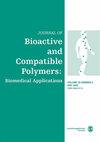带有阳离子铵基团的光动力抗菌纳米粒子的制备和抗菌能力
IF 2.1
4区 生物学
Q3 BIOTECHNOLOGY & APPLIED MICROBIOLOGY
引用次数: 0
摘要
随着耐药细菌感染的不断增加,如何找到根除耐药细菌及其生物膜的新方法已成为研究人员面临的巨大挑战。光动力抗菌化疗(PACT)因其独特的抗菌机制,能有效灭活耐药菌,且不会诱发进一步的耐药性,成为新型抗菌策略中不可或缺的一部分。本研究采用微乳液聚合法成功制备了以 N-异丙基丙烯酰胺和甲基丙烯酰氧乙基三甲基氯化铵为单体、负载荧光共轭聚合物的纳米粒子。平均粒径为 100 至 200 nm。根据其 zeta 电位分析,纳米粒子能稳定地分散在水中。纳米颗粒在波长为 500-700 纳米的光照下会产生单线态氧。分别对大肠杆菌、金黄色葡萄球菌和耐甲氧西林金黄色葡萄球菌的 PACT 效能进行了研究。结果表明,当浓度大于 0.01 毫克/毫升、光照时间为 30 分钟时,纳米颗粒的抗菌能力非常出色。当纳米颗粒的质量浓度等于或大于 0.05 mg/mL 时,抗菌机制以阳离子作用为主;当浓度等于或小于 0.01 mg/mL 时,纳米颗粒的抗菌能力通过光动力作用得到有效提高。定量研究了纳米颗粒溶液对生物膜中细菌的抗菌率,结果证明,纳米颗粒浓度在 0.2 mg/mL 或更高时,纳米颗粒能有效消除生物膜中的细菌。结果表明,纳米粒子能有效穿透生物膜,通过光照杀死生物膜内的细菌。本文章由计算机程序翻译,如有差异,请以英文原文为准。
Preparation and antibacterial ability of photodynamic antibacterial nanoparticles with ammonium cationic groups
With the increasing infection of drug-resistant bacteria, it has become a great challenge for researchers to find new approaches to eradicate drug-resistant bacteria and their biofilms. Photodynamic antimicrobial chemotherapy (PACT) is an indispensable part of the new anti-bacterial strategy because of its unique anti-bacterial mechanism, which can effectively inactivate drug-resistant bacteria without inducing further drug resistance. In this work, nanoparticles with N-isopropylacrylamide and methacryloxyethyltrimethyl ammonium chloride as monomers, and loaded with a fluorescent conjugated polymer were successfully prepared by microemulsion polymerization. The average particle size ranged from 100 to 200 nm. The nanoparticles could disperse in water steadily according to their zeta potential analysis. The nanoparticles generated singlet oxygen upon exposing to light with wavelength of 500–700 nm. Their PACT efficiency was investigated against Escherichia coli, Staphylococcus aureus, and methicillin-resistant Staphylococcus aureus respectively. The results indicated that the antibacterial ability of nanparticles were excellent as the concentration was more than 0.01 mg/mL and the illumination time was 30 min. When the mass concentration of the nanoparticles was equal to or more than 0.05 mg/mL, the antibacterial mechanism was dominated by cation action, and when the concentration was equal or lower than 0.01 mg/mL, the antibacterial ability of the nanoparticles was improved effectively by photodynamic action. The antibacterial rate of the nanoparticle solutions against the bacteria in the biofilm was quantitatively studied, and it was proved that the nanoparticles eliminated bacteria in the biofilm effectively with a nanoparticle concentration of 0.2 mg/mL or more. The results indicated that the nanoparticles could effectively penetrate the biofilm to kill bacteria inside the biofilm by light illumination.
求助全文
通过发布文献求助,成功后即可免费获取论文全文。
去求助
来源期刊

Journal of Bioactive and Compatible Polymers
工程技术-材料科学:生物材料
CiteScore
3.50
自引率
0.00%
发文量
27
审稿时长
2 months
期刊介绍:
The use and importance of biomedical polymers, especially in pharmacology, is growing rapidly. The Journal of Bioactive and Compatible Polymers is a fully peer-reviewed scholarly journal that provides biomedical polymer scientists and researchers with new information on important advances in this field. Examples of specific areas of interest to the journal include: polymeric drugs and drug design; polymeric functionalization and structures related to biological activity or compatibility; natural polymer modification to achieve specific biological activity or compatibility; enzyme modelling by polymers; membranes for biological use; liposome stabilization and cell modeling. This journal is a member of the Committee on Publication Ethics (COPE).
 求助内容:
求助内容: 应助结果提醒方式:
应助结果提醒方式:


